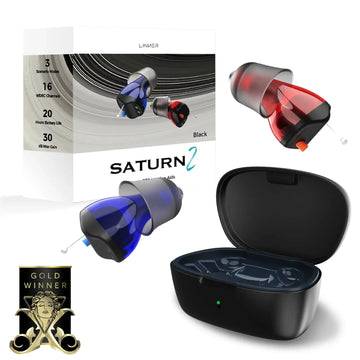
OTC hearing aids
Over-the-counter (OTC) hearing aids have been approved by the FDA for the use of adults over the age of 18 years; These devices are intended for use for individuals with mild to moderate hearing loss (1). They may be purchased directly from a retailer or manufacturer without the requirement of a professional diagnostic testing or fitting (2). This specific product feature eliminates a significant portion of the cost to consumers as compared to a prescription hearing aid.
The design, size, and shape of OTC hearing aids are typically indistinguishable from prescription behind-the-ear (BTE) or receiver-in-the-canal (RIC) hearing aids. Thus, there is no cosmetic compromise when selecting an OTC device. OTC manufacturers also offer a wide range of earpieces (domes) to accommodate most ear canal sizes and shapes. A crucial detail for a successful hearing aid fitting is to select the correct dome for your ear. Furthermore, a deep insertion of the dome and speaker (hearing aid receiver) will give the user the best sound experience. If you are not able to insert the hearing aid receiver and dome well into the canal, consider selecting a smaller size. Experimentation is your friend!
OTC hearing aids have similar features as prescription hearing aids such as: rechargeable batteries, Bluetooth connectivity, directional microphones, feedback management, and noise reduction functionality; all these features are found in the LINNER product line. A publication from the American Journal of Audiology reports that mid-range priced ($100-$500 cost) OTC hearing aids can reliably
amplify speech according to the National Acoustic Laboratory standards (3). Researchers concluded that OTC hearing aids are a suitable option for price-conscious consumers, and they may offer similar outcomes to prescription hearing aids (4).
As previously mentioned, LINNER hearing aids are Bluetooth capable devices. Connecting your hearing aid to your smartphone will greatly improve phone conversations, because the speech from the phone is directly heard directly though the hearing aids, instead of through the phone’s small speaker. Be sure to connect your LINNER hearing aids to your smartphone to take advantage of this feature and the LINNER app, which can be found on the Google Play store or Apple App Store at no cost.
As a clinical audiologist, I view OTC hearing aids as an excellent tool in the hearing health arsenal for patients who are struggling with speech understanding and clarity; clinical research has supported this assertion. LINNER offers an excellent product line of OTC hearing aids and assistive devices to ease the barrier of entry for the hearing patient.
(1) FDA Finalizes Historic Rule Enabling Access to Over-the-Counter Hearing Aids for Millions of Americans. (2022). Retrieved from: http://www.fda.gov/news-events/press-announcements/fda-finalizes-historic-rule-enabling-access-over-counter-hearing-aids-millions-americans
(2) OTC Hearing Aids: What You Should Know. (2023). Retrieved from:http://www.fda.gov/medical-devices/hearing-aids/otc-hearing-aids-what-you-should-know
(3) Callaway, S. L., & Punch, J. L. (2008). An electroacoustic analysis of over-the-counter hearing aids. American journal of audiology, 17(1), 14–24.https://doi.org/10.1044/1059-0889(2008/003)
(4) Swanepoel, W., Oosthuizen, I., Graham, M. A., & Manchaiah, V. (2023). Comparing Hearing Aid Outcomes in Adults Using Over-the-Counter and Hearing Care Professional Service Delivery Models. American journal of audiology, 32(2), 314–322. https://doi.org/10.1044/2022_AJA-22-00130


![Linner Mercury Clarity OTC Hearing Aids [FSA & HSA Eligible] Linner](http://www.linnerlife.com/cdn/shop/files/Linner-Mercury-Clarity-OTC-Hearing-Aids-_FSA-_-HSA-Eligible_-Linner-110038953.webp?v=1725853434&width=360)

![Linner Mars OTC Hearing Aids [FSA & HSA Eligible] Linner](http://www.linnerlife.com/cdn/shop/files/Linner-Mars-OTC-Hearing-Aids-_FSA-_-HSA-Eligible_-Linner-110039213.webp?v=1725865495&width=360)
